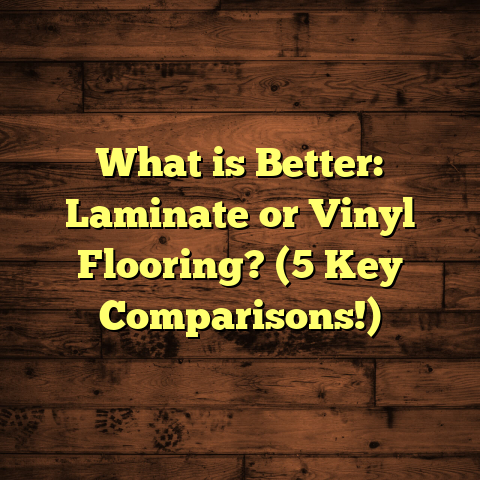What is Cheaper: Laminate or Ceramic Tile Floors? (5 Key Comparisons)
Remember those floors you grew up with? The ones you’d race across as a kid or lay on during lazy afternoons? I still recall the feeling of my feet on cool tiles in the kitchen or the wood-like warmth in the living room. Floors aren’t just surfaces we walk on; they shape our everyday experience at home. If you’re thinking about replacing or choosing new flooring, you might be wondering: what’s cheaper, laminate or ceramic tile? I’ve worked in flooring for years, and I want to walk you through five key points that helped me and my clients decide wisely.
What Is Laminate and Ceramic Tile Flooring?
Before diving into the numbers, let me explain what these floor types really are.
Laminate Flooring
Laminate flooring is a synthetic product designed to mimic natural materials, mostly wood but sometimes stone or tile looks. It’s made of several layers — a high-density fiberboard core sandwiched between a photographic image layer and a protective wear layer. This wear layer guards against scratches and stains.
One reason laminate flooring got popular is because it mimics hardwood at a fraction of the cost. It’s also relatively easy to install — many brands offer “click-lock” planks that don’t require nails or glue. What’s cool is it can be installed over different types of subfloors, including concrete and plywood, making it versatile.
In my early days installing floors, I was impressed by how laminate flooring could transform a space quickly without the expense or hassle of solid wood.
Ceramic Tile Flooring
Ceramic tile is made from natural clay fired at high temperatures to create hard, durable tiles. These come in many shapes, sizes, colors, and finishes — glazed or unglazed.
Tile is very popular in wet areas like kitchens, bathrooms, and entryways because it resists water well and is easy to clean. It’s also heat resistant and can accommodate radiant floor heating systems.
Unlike laminate, ceramic tile installation requires more preparation and skill — mortar bed application, precise tile placement, grout application, and sealing. But the payoff is a floor that lasts decades with minimal wear.
I remember installing ceramic tile in an older home where the kitchen floor had suffered from moisture damage over years. The new tile not only looked fresh but also stood up to heavy use without issues.
1. Initial Cost of Materials: How Much Will You Pay Upfront?
Let’s start with what hits your wallet first — the material cost.
Laminate Material Pricing
Laminate flooring is often chosen because it’s budget-friendly. Prices vary widely depending on brand, thickness, wear layer quality, and design complexity.
Basic laminates can cost as low as $1 per square foot. Mid-range laminates typically run $2-$3 per square foot. Premium laminates with thicker wear layers or special textures might reach $4-$5 per square foot.
If you’re covering 1,000 square feet, basic laminate material might cost roughly $1,000, while premium options could be up to $5,000.
What’s interesting is that some modern laminates come with waterproof cores, making them suitable even for kitchens or basements — something older versions couldn’t claim.
Ceramic Tile Material Pricing
Ceramic tile prices depend on size, finish, pattern, and manufacturer. Basic ceramic tiles can start around $3 per square foot. Mid-range tiles are usually $5-$7 per square foot. Designer porcelain or specialty tiles can reach $10 or more per square foot.
For the same 1,000-square-foot project, materials might cost between $3,000 to $10,000 depending on your choice.
I once worked on a client’s kitchen remodel where she wanted “farmhouse chic” look with hand-painted tiles. The material alone was nearly triple what laminate would have been for the same area.
Why Prices Differ
- Laminate uses synthetic materials produced in factories at scale.
- Ceramic tiles require natural clay and firing processes.
- Intricate designs or larger tiles add to ceramic costs.
- Laminate’s photographic layer allows mass production of many looks cheaply.
Personal Story on Budgeting
When I first helped my sister redo her basement floor (about 600 sqft), she was torn between laminate and ceramic tile. Her budget was tight — roughly $2,000 for materials and labor combined.
We priced out laminate at about $1.75/sqft — roughly $1,050 for materials. Ceramic tile was about $6/sqft — $3,600 just for tile! So laminate made sense there.
She ended up loving how easy it was to install laminate herself and even saved some money for new furniture.
2. Installation Costs & Complexity: What Will You Spend on Labor?
Material costs are only part of the story — installation can change the equation entirely.
Laminate Installation
Laminate is known for being DIY-friendly due to its floating floor system. You don’t have to glue or nail it down; planks snap together over underlayment.
Labor costs usually range from $1 to $3 per square foot if you hire professionals. This includes prepping the subfloor, laying underlayment, snapping planks together, cutting edges for fit, and finishing with trim.
DIY installation can save you this labor charge but requires time and some skill with tools like saws and spacers.
In my experience installing laminate floors myself twice now, it took about 3 days for roughly 500 square feet each time — manageable but physically demanding work.
Ceramic Tile Installation
Tile installation is much more labor intensive:
- Subfloor preparation (sometimes reinforcing)
- Applying thin-set mortar evenly
- Laying each tile with precision
- Cutting tiles to fit corners/edges
- Grouting after mortar dries
- Sealing grout once cured
Professional tile installation typically ranges from $5 to $10 per square foot in labor costs — sometimes more for complex patterns or large-format tiles.
I recall a kitchen job where tile installation alone took nearly a week for 300 square feet because of intricate mosaics and uneven walls requiring extra prep work.
Total Installation Costs Example
| Flooring Type | Material Cost | Labor Cost | Total Cost (1,000 sqft) |
|---|---|---|---|
| Laminate | $2,500 | $2,000 | $4,500 |
| Ceramic Tile | $6,000 | $7,500 | $13,500 |
My Tip for Saving on Installation
If you’re handy with tools and have time, laminate is a great DIY project — saving thousands in labor costs. For tile, consider hiring pros unless you have experience because mistakes can be costly to fix later.
I’ve seen some clients try tile DIY and end up with uneven tiles or cracked grout that required redoing by pros anyway — costing more overall.
3. Durability: What Lasts Longer?
The lifespan of your flooring affects how much value you get for your money over time.
Laminate Durability
Laminate floors last 10-25 years depending on quality and care. High-quality laminates have thick wear layers that resist scratches well.
However:
- Laminate is prone to water damage — standing water can cause swelling or warping.
- Heavy impacts can chip or crack planks.
- Once damaged beyond repair in an area, replacing planks may be tricky if stock is unavailable.
I remember a client whose dog scratched the laminate badly after about 8 years. We replaced several planks but had trouble matching colors exactly since the product line was discontinued.
Ceramic Tile Durability
Ceramic tiles are incredibly durable — often lasting 50+ years without needing replacement.
- They resist water completely.
- Scratches rarely show.
- Heat or heavy objects don’t damage them easily.
- Grout needs maintenance but tiles themselves remain strong.
In one historic home renovation I worked on, original ceramic tiles from 70 years ago were still intact — just required cleaning and minor grout repairs.
Real-Life Cases
- A laminate floor in a busy family home showed wear after 15 years but still looked decent.
- A ceramic tiled bathroom floor installed by me 20 years ago needed only occasional grout sealing but no tile replacement.
Consider Your Lifestyle
If you have kids or pets who might scratch floors or spill water often:
- Laminate may need earlier replacement.
- Tile will stand up better but costs more initially.
4. Maintenance and Repair: What Costs Come Later?
It’s easy to forget about maintenance until something breaks or gets dirty.
Laminate Maintenance
Laminate is low maintenance:
- Sweep/dry mop regularly.
- Avoid soaking with water.
- Use recommended cleaning products.
- Place protective pads under furniture legs.
Repairs are less straightforward:
- You usually replace entire planks.
- Some brands allow plank replacement; others don’t.
- Matching color/texture after years can be tough due to fading.
Repair costs typically run $50-$150 per plank including labor if you hire someone.
I once had to replace three damaged planks after a plumbing leak damaged an area. The process was frustrating because it involved lifting baseboards carefully and cutting exact replacements.
Ceramic Tile Maintenance
Tile requires:
- Regular sweeping/mopping.
- Occasional grout cleaning with special cleaners.
- Resealing grout every few years (depending on grout type).
- Replacing cracked/chipped tiles as needed.
Tile repairs are generally less invasive:
- Replace individual tiles easily without disturbing neighbors.
- Grout repairs are simple fixes for minor issues.
Repair costs can range from $10-$30 plus labor per tile replacement.
A client I worked with had grout discoloration after years but avoided tile replacement by just resealing grout — a cheap fix compared to replacing planks in laminate floors.
5. Resale Value & Aesthetic Appeal: Will It Help You Sell?
If you ever plan to sell your home (or want it to look great for guests!), the floor matters more than you think.
Laminate Resale Value
Laminate has come a long way in looks but still isn’t seen as “high end” by many buyers. Some buyers prefer real hardwood or tile over laminate due to perceived durability and quality differences.
Still:
- High-quality laminates can impress if well maintained.
- Great for modern casual styles.
- Less appealing in luxury markets or traditional homes.
Ceramic Tile Resale Value
Ceramic tile usually adds more value:
- Seen as durable and premium.
- Popular in kitchens/baths where moisture is common.
- Offers timeless appeal with many style choices.
- Can increase perceived home quality noticeably.
According to real estate reports I’ve reviewed:
Homes with ceramic tile floors in kitchens/baths tend to sell faster and at higher prices than those with laminate in similar areas.
My Personal Observations
I’ve had clients who upgraded from laminate to ceramic tile before selling their homes report positive feedback from buyers appreciating the quality upgrade despite higher upfront costs.
Additional Factors That Affect Cost Comparisons
Let’s look beyond straight price tags because real-world decisions depend on more than just numbers.
Waste Factor During Installation
One subtle point many overlook is waste — extra material ordered to cover cuts, mistakes, or breakage during installation.
For laminate:
- Waste factor typically around 5%-10%.
For ceramic tile:
- Waste factor can be higher (10%-15%) especially with patterned or large tiles that require precise cuts.
The result? You might need more tile material than measured floor area suggests which raises costs slightly.
In one job involving diagonal-laid tiles (which create more cuts), waste was nearly 15%, adding a few hundred dollars in material expenses compared to straight-laid laminate with 5% waste.
How FloorTally Helps Me Manage These Calculations
You might wonder how I keep track of all these moving parts when advising clients or planning projects myself. That’s where FloorTally comes in handy.
Instead of juggling spreadsheets with prices from different suppliers plus guesses on labor rates and waste factors, FloorTally lets me input local costs directly and provides detailed estimates quickly. It also accounts for waste percentages automatically based on material type and installation style — something that saves me headaches later when ordering materials.
When I helped a client last month choose between laminate and ceramic tile for her new kitchen and adjoining living room (around 850 sqft), FloorTally gave me clear comparisons including total materials cost, labor estimates based on local rates, waste factor impacts, even options for different underlayments or grout types for tile jobs.
This made explaining options simple: she could see how spending an extra few thousand upfront on tile might save money down the road via durability but also how laminate would fit her tight budget now without sacrificing too much style.
My Flooring Experiences: Lessons Learned Over the Years
Let me share some stories from my work that might give you perspective beyond numbers:
- The Basement Project
My sister wanted affordable flooring that could handle moisture risks in her basement rec room. We chose waterproof laminate after researching pros/cons carefully. The install was straightforward DIY over two weekends using FloorTally numbers as our budget guide. The floor has worn well for 5 years now — no swelling or damage — proving newer laminates can handle basements if chosen right.
- The Kitchen Remodel
A client wanted ceramic tile for its classic look but hesitated due to costs. After showing her detailed labor + material quotes from FloorTally plus durability benefits over 20+ years versus laminate replacement cycles, she decided on tile. The project took longer but she loves that floor today — easy cleanup after spills and looks great even years later.
- The Rental Property
For rental units where budgets are tight but tenants rough on floors, I often suggest mid-tier laminate that balances cost and durability well while enabling quick future replacements if needed without huge expense or downtime.
Frequently Asked Questions About Laminate vs Ceramic Tile Costs
Q: Can I install ceramic tile myself to save money?
A: Unless you have experience tiling before, I don’t recommend it. Mistakes like uneven mortar or improper grouting are costly fixes that professionals avoid due to training/tools.
Q: Is laminate waterproof?
A: Most traditional laminates are not waterproof; water can seep into seams causing swelling. But newer waterproof varieties exist; just check product specs carefully before buying for wet areas.
Q: Which flooring type is better for radiant heat?
A: Ceramic tile works best with radiant heating systems because it conducts heat efficiently. Laminate can be used but requires special underlayments compatible with heating elements.
Q: How often do I need to reseal grout?
A: Typically every 2-5 years depending on grout type and exposure to moisture/traffic levels; neglecting this can cause staining or deterioration sooner.
Summary Table: Quick Cost & Feature Comparison Between Laminate and Ceramic Tile Floors
| Feature | Laminate Flooring | Ceramic Tile Flooring |
|---|---|---|
| Material Cost | $1 – $5 / sq ft | $3 – $10 / sq ft |
| Installation Cost | $1 – $3 / sq ft | $5 – $10 / sq ft |
| Lifespan | 10 – 25 years | 50+ years |
| Water Resistance | Limited (some waterproof options) | Excellent |
| Maintenance | Low; avoid water exposure | Moderate; grout cleaning/sealing |
| Repair | Replace planks; sometimes tricky | Replace individual tiles easily |
| Resale Value | Moderate | Higher |
| DIY Friendly | Yes | No (usually) |
Wrapping Up Our Chat
So what’s cheaper? The answer depends on your priorities:
- If upfront cost and ease of installation matter most — laminate wins hands down.
- If you want durability and long-term savings with better resale appeal — ceramic tile pays off despite higher upfront costs.
I’ve helped clients make these choices many times by breaking down costs clearly using tools like FloorTally paired with hands-on experience installing both types myself — so feel free to ask if you want help estimating your project!
At the end of the day, either choice can look fantastic when picked thoughtfully and installed well. It’s about balancing budget with lifestyle needs while keeping your home comfy underfoot for years ahead.
Got questions about your specific project? Let’s talk details!





